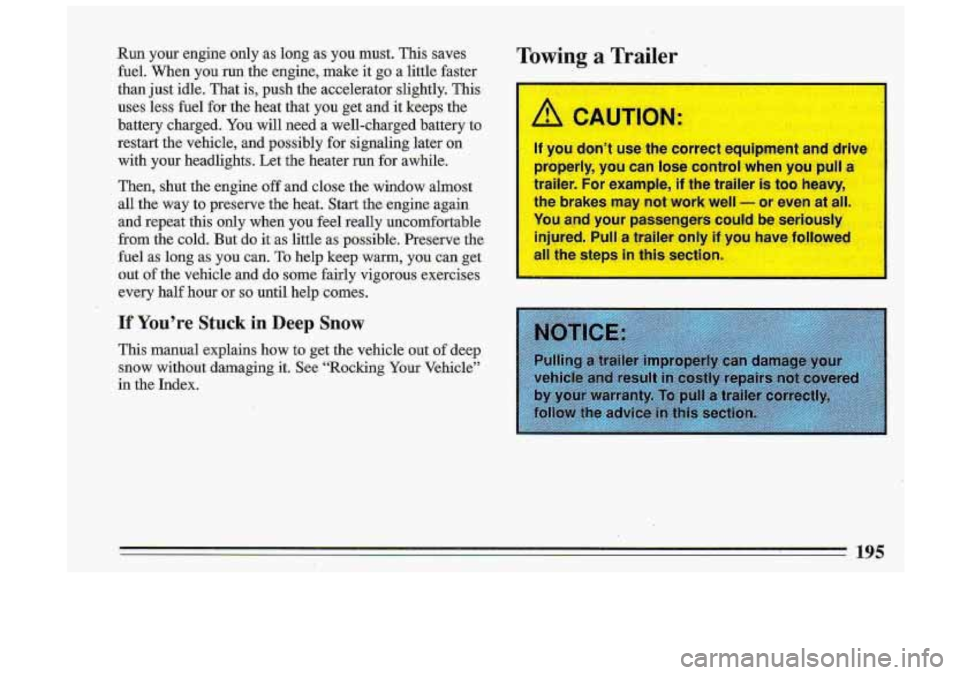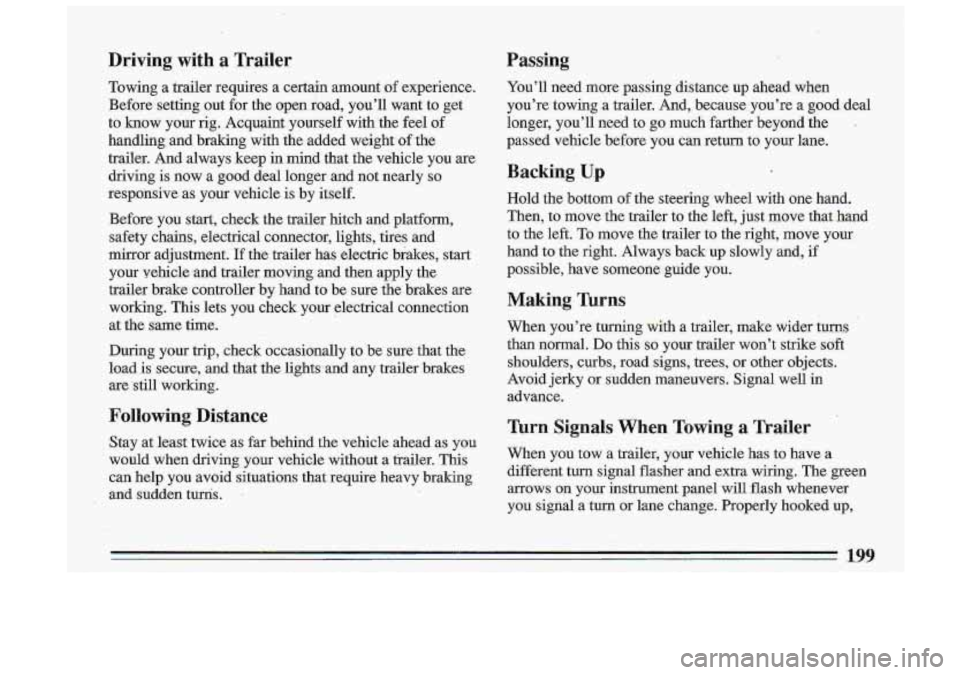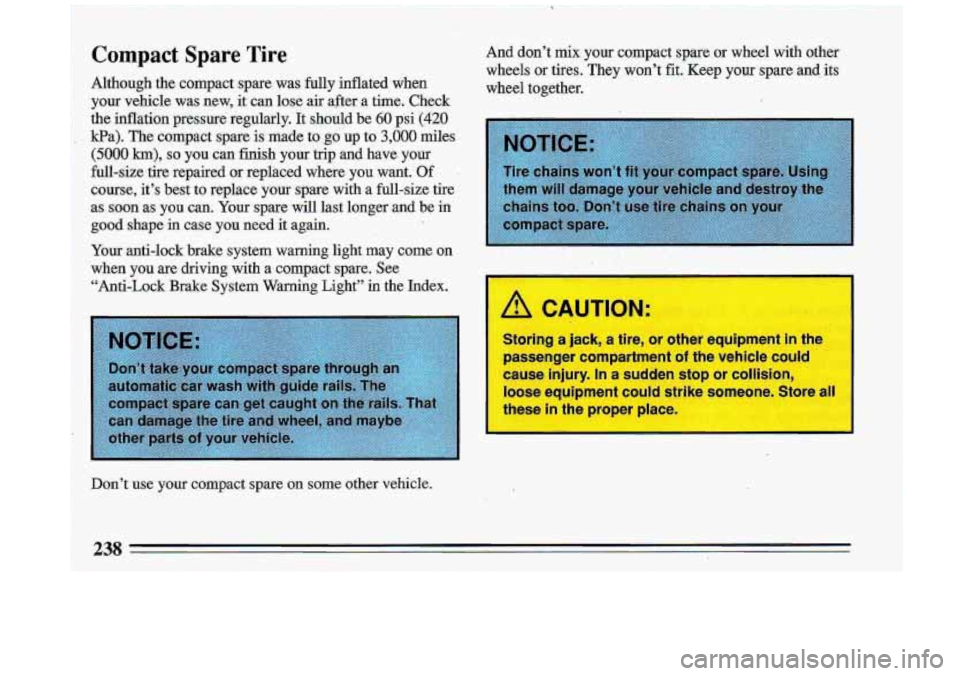Page 183 of 340
Tips on Driving in Fog
If you get caught in fog, turn your headlights on low
beam, even in daytime. You’ll see
- and be seen -
better.
Pass other vehicles in fog only if you can see far enough
ahead to pass safely. Even then, be prepared to delay
your pass if you suspect the
fog.is worse up ahead. If
other vehicles try to pass you, make it easy for them.
*
If visibility is near zero and you must stop but are
unsuTe whether you are away
from the road, turn your
lights on, start
your hazard warning flasher, and sound
your
Born at intervals or when you hear approaching
traffic. One
of the
biggest problems with city streets is the
amount of traffic
on them. You’ll want to watch out for
what the other drivers are doing and pay attention
to
traffic signals.
181
Page 187 of 340
I
!i 1 I
I
0
0
Wear good sunglasses in bright light. Glare can.
cause drowsiness.
But don’t wear sunglasses at I
night. They will drastically reduce your overall
vision at the very time you need all the seeing power
you have.
If you get sleepy, pull
off the road into a’rest, service,
or parking area and take a nap, get some exercise,
or
both. For safety, treat drowsiness on the highway as.
1
an emergency.
As in any driving situation, keep pace with traffic and
allow adequate following distances.
185
Page 193 of 340
Winter Driving
Here are some tips for winter driving:
Have your Buick in good shape for winter. Be sure
your engine coolant mix is co-rrect.
Snow tires. can help in loose snow, but they may give
you less traction on ice than regular tires. If you do
not expect to be driving
in deep snow, but may have
to travel over ice,
you may not want to switch to
snow tires at all.
You may want to put winter emergency supplies in
your vehicle.
I
I
.. . ..
Include an.ice:scrapGq a small brush .or broom, a supply
of'windshield washer fluid,
a rag, some winter outer
clothing,
a small shovel, a flashlight, a, red. cloth,. and a
couple
.of reflective warning triangles. And, if you will
be driving under:severe conditions, include a small bag
of sand, a piece of ,old carpel .or a couple of burlap. bags
to help provide traction. Be sure y.ou properly secure
these items in your vehicle.
Page 197 of 340

Run your engine only as long as you must. This saves
fuel. When you
run the engine, make it go a little faster
than just idle. That is, push the accelerator slightly. This:
uses less fuel for the heat that you get and it keeps the
battery charged.
You will need a well-charged battery to
restart the vehicle, and possibly for signaling later
on
with your headlights. Let the heater run for awhile.
Then, shut the engine
off and close the window almost
all the way to preserve the heat. Start the engine again
and repeat this only when you feel really uncomfortable
from the cold. But do
it as 'little as possible. Preserve the
fuel
as long as you can. To help keep warm, you can get
out of the vehicle and
do some fairly vigorous exercises
every half hour or
so until help comes.
Towing, a Trailer
/! CAUTION-
If you don't use the correct equipment and drive
properly, you can lose control when you
pull a
trailer.
For example, if the trailer is too heavy,
I the brakes may not work well - or even at all,
You and your passengers could be seriously'
injured. Pull
a trailer only if you have followed
I the steps in this section.
Page 201 of 340

Driving with a Trailer
Towing a trailer requires a certain amount of experience. Before setting out for the open road, you’ll want to get
to
know your rig. Acquaint yourself with the feel of
handling and braking. with the added weight of the
trailer. And always keep in mind that the vehicle you are
driving is now
a good deal longer and not nearly so
responsive as your vehicle is by itself.
Before you start, check the trailer hitch and platform,
safety chains, electrical connector, lights, tires and
mirror adjustment.
If the trailer has electric biakes, start
your yehicle and trailer moving and then apply the
trailer brake controller by hand to be sure the- brakes are
working. This lets you check your electrical connection
at the same time.
During your trip, check occasionally to
be sure that the
load
is secure, and that the Lights.and any trailer brakes
are .still working.
Following Distance
Stay at least twice as far behind the vehicle ahead as you
would when driving your vehicle without a trailer. This
can help
you avoid situations that require heavy braking
and sudden turris.
.
Passing
You’ll need. more passing distance up ahead when
you’re towing a trailer. And, because you’re a good deal \
longer, you’ll need to go much farther beyond the
.
passed vehicle before you can return to your lane.
Backing Up
Hold the bottom of the steering wheel with one hand.
Then, to move the trailer
to the left, just move that hand
to the left.
To mo.ve the trailer to the right, move your
hand to the right. Always back up slowly and, if
possible, have someone guide
you.
Making Turns
When you’re turning with a trailer, make wider turns
than normal.
Do this so your trailer won’t strike soft
shoulders, curbs, road signs, trees, or other objects.
Avoid jerky or sudden maneuvers. Signal well in
advance.
Turn Signals When Towing a Trailer
When you tow a trailer, your vehicle has to have .a
different turn signal flasher and extra wiring. The green
arrows on your instrument panel will
flash whenever
you signal a
turn or lane change. Properly hooked up,
199
Page 207 of 340
7 Press the button in to. ~ make your front and, rear
i : turn s$gnal .lights' flash on
and
off. .. . ,.
,.
I .'
Your hazard warning -flashers work no' matter wnat
position your key is in, and even if the key isn't in.
To turn off the flashers,
pull out on the collar.
When the hazard
warning
flashers are on, your turn
signals won't work.
Other Warning Devices
If you carry reflective triangles; you can set one up at
the side
of the road about 300 feet (100 m) behind your
vehicle.
205
Page 209 of 340
I
I
You eou be injured ! V€ !s roll
parking brake firmly on each vehicle. Put an
automatic transmission
in ‘‘P” (Park) or a
manu nsl in 9
3. Twm off the ignition .on both vehicles. Turn ofr all
lights that aren’t needed, and radios. This will avoid
sparks- and help save both batteries. And
it could
save your radio!
4. Open the hoods and locate the batteries. Find the
positive (+) and negative (-) terminals on each
battery. Your Buick has two remote positive.
(+) jump
starting terminals.
The terminals are in the red box
on the. same side’of the engine compartment BS your
battery.You should always use one, of the remote
.positive
(+) terminals instead of the positive (+)
terminal on your battery.
To open the remote positive (+) terminal box, pull
the tab and open the cover.
Page 240 of 340

Compact Spare T,ire
Although the compact spare was fully inflated when
your vehicle -was new, it can lose air after a time. Check
the inflation pressure regularly. It should be
60 psi (420
Pa). The compact spare is made to g6 up to 3,000 miles
(50,OO km), so you can finish your trip and have. your
full-size tire repaired
or replaced where you want. Of
course, it’s best to replace your spare with a full-size ti\
re
as soon as you can. Your spare will last longer and be in
good shape in case you need it again.
Your anti-1ock.brake system warning light -may come on
when you are driving with a compact spare. See
“Anti-Lock Brake System Waming Light”
in the Index.
Don’t-use
your compact spare on some other vehicle. And don’t mix your compact spare or wheel
with other
wheels or tires. They. won’t
fit.. Keep your spare and its
wheel together.
., ,. .. .. , ...
L CAUTIOF
s J a Jal , a we, or orner equlpmenr in rn
passenger compartment of the vehicle could
cause injury. In
a sudden stop or collision,
loose equipment could strike someone. Store al
these
in the proper place
3s